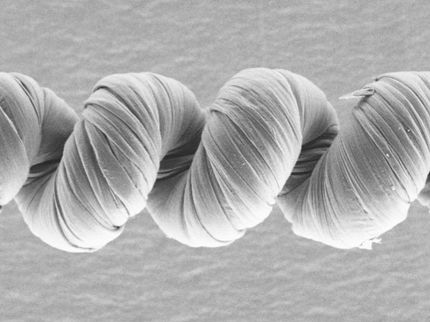Silicone films for artificial muscles
Researchers of the University of Basel and Empa have gotten a step closer to engineering artificial muscles: they have developed a method to generate nanometer-thin silicone films.
Elastomers, which can transform electrical energy into mechanical energy, have a wide variety of applications, i.e. powering windscreen wipers, sound generation, and operating camera lenses. By surrounding the synthetic material with electrodes and applying operation voltage, it expands laterally. In the field of medicine, this principle is promising for the development of artificial muscles for treating severe incontinence, as the consortium recently communicated.
To provide the necessary strain, micrometer-thick silicone layers need an operation voltage of several hundred volts, which is by far too high for applications within the human body. In contrast, nanometer-thin layers require only a few volts. To generate forces necessary to reach continence, several thousand layers have to be put on top of each other.
Coating using electrospray
Current manufacturing methods do not allow the efficient fabrication of such layered nanostructures. The team of Prof. Müller from the Biomaterials Science Center of the University of Basel, together with researchers of Empa, has developed a deposition method to prepare extremely flat silicone layers that are much thinner than a micron. The roughness is smaller than one nanometer. For this purpose, silicone molecules in solution are sprayed assisted by high voltages – termed electrospray deposition.
Usually electrospraying is based on direct current. The researchers from Basel, however, employ an alternating current. “This rather simple deposition technique has a huge potential, as it is adaptable to the industrial requirements for producing artificial muscles as well as powering windscreen wipers”, Bert Müller said. He expects that patients suffering from severe incontinence could benefit from the technology.
Original publication
Florian M. Weiss, Tino Töpper, Bekim Osmani, Sven Peters, Gabor Kovacs, and Bert Müller; "Electrospraying Nanometer-Thin Elastomer Films for Low-Voltage Dielectric Actuators"; Advanced Electronic Materials; 2016, 1500476
Florian M. Weiss, Tino Töpper, Bekim Osmani, Hans Deyhle, Gabor Kovacs, and Bert Müller; "Thin Film Formation and Morphology of Electro-sprayed Polydimethylsiloxane"; Langmuir; 2016
Elisa Fattorini, Tobia Brusa, Christian, Gingert, Simone E. Hieber, Vanessa Leung, Bekim Osmani, Marco D. Dominietto, Philippe Büchler, Franc Hetzer, and Bert Müller; "Artificial Muscle Devices: Innovations and Prospects for Fecal Incontinence Treatment"; Annals of Biomedical Engineering; 2016
Original publication
Florian M. Weiss, Tino Töpper, Bekim Osmani, Sven Peters, Gabor Kovacs, and Bert Müller; "Electrospraying Nanometer-Thin Elastomer Films for Low-Voltage Dielectric Actuators"; Advanced Electronic Materials; 2016, 1500476
Florian M. Weiss, Tino Töpper, Bekim Osmani, Hans Deyhle, Gabor Kovacs, and Bert Müller; "Thin Film Formation and Morphology of Electro-sprayed Polydimethylsiloxane"; Langmuir; 2016
Elisa Fattorini, Tobia Brusa, Christian, Gingert, Simone E. Hieber, Vanessa Leung, Bekim Osmani, Marco D. Dominietto, Philippe Büchler, Franc Hetzer, and Bert Müller; "Artificial Muscle Devices: Innovations and Prospects for Fecal Incontinence Treatment"; Annals of Biomedical Engineering; 2016
Organizations
Other news from the department science

Get the chemical industry in your inbox
By submitting this form you agree that LUMITOS AG will send you the newsletter(s) selected above by email. Your data will not be passed on to third parties. Your data will be stored and processed in accordance with our data protection regulations. LUMITOS may contact you by email for the purpose of advertising or market and opinion surveys. You can revoke your consent at any time without giving reasons to LUMITOS AG, Ernst-Augustin-Str. 2, 12489 Berlin, Germany or by e-mail at revoke@lumitos.com with effect for the future. In addition, each email contains a link to unsubscribe from the corresponding newsletter.




























































